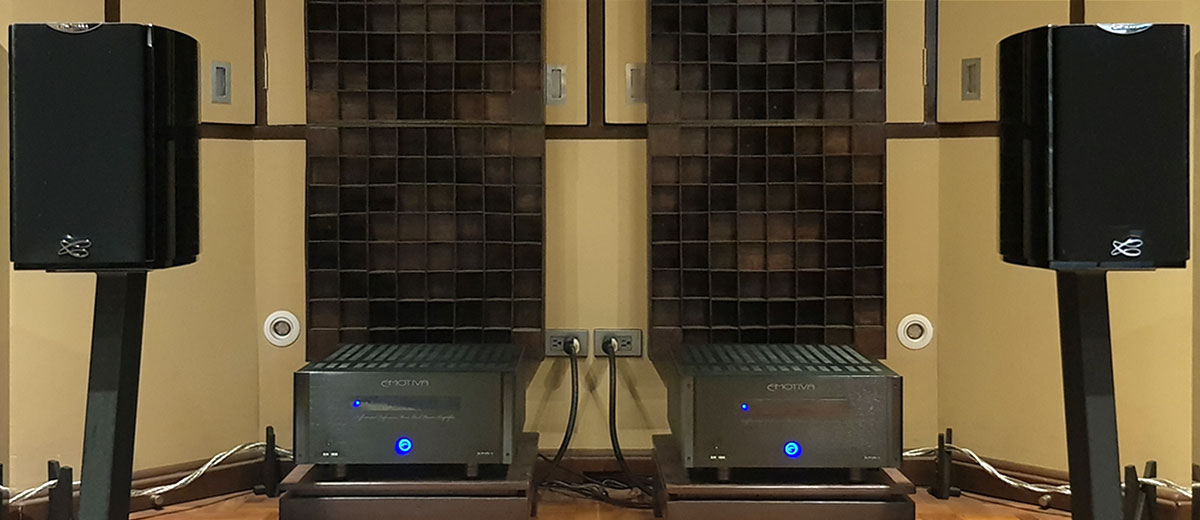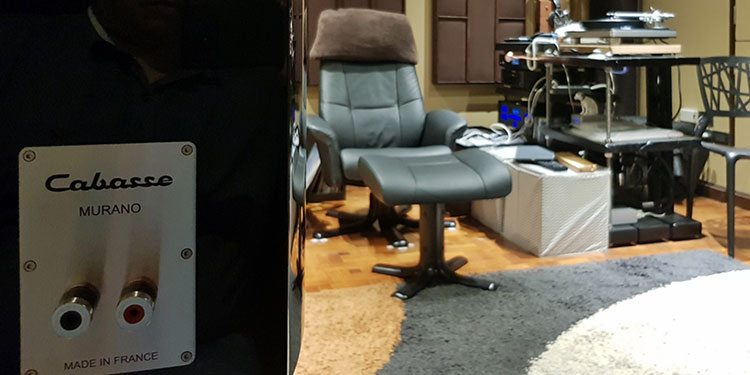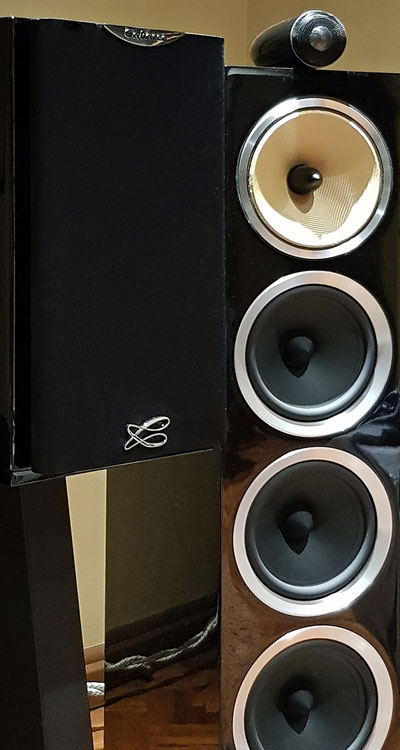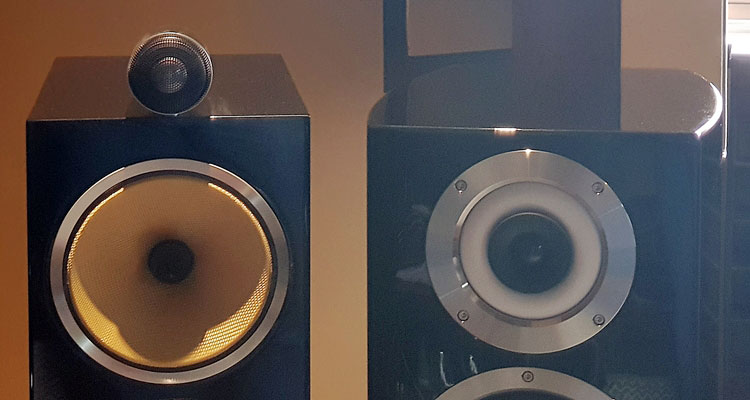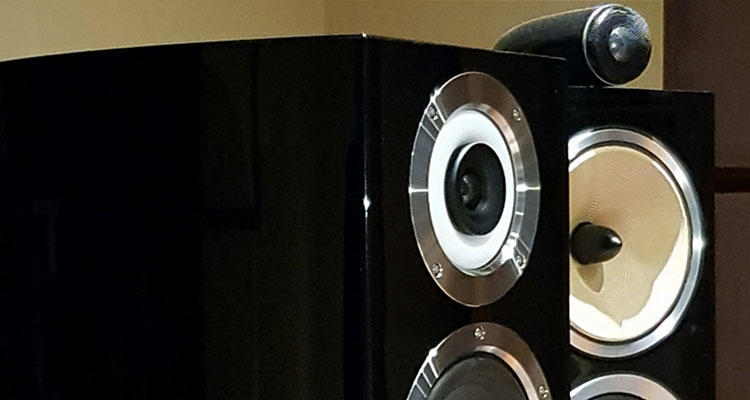Sound Impressions
Setup
I placed the Cabasse Murano on a pair of 18-inch tall sand-filled metal stands. This raises the coaxial midrange and tweeter combo to within an inch or two of my seated ear level. Small gobs of “Blu-Tack Black” compound couple them to the stands.
Since the listening room is symmetrical, I positioned them roughly 2 feet from the sidewalls, 3 feet from the front walls, and a little over 6 feet apart. Incidentally, this is where other bookshelf speakers sounded best in the room.
No toe-in at first. My own pair of B&W CM10 S2 floor standing speakers are toed-in such that I can barely see their inner sidewalls from the listening chair. With the Murano, both point directly at the back wall. Lastly, the grill. I attached them and this is what gave me the smoothest and most balanced tonal signature.
Break-in
All loudspeakers contain moving parts held in place by flexible components. Manufacturers do their best to ensure the flexibility remains consistent over time but age, use (and abuse), as well as variations in ambient temperature and humidity do eventually cause measurable changes.
For example, it is many times warmer and more humid here than it is in France, Murano’s country of origin. This will affects how the loudspeaker sounds. For these reasons, I decided to “break-in” the brand-new Cabasse Muranos before doing any critical listening.
I played jazz, pop, and R&B at normal listening levels non-stop for around two weeks. Naturally, I thought about my neighbors. That is why the listening room is soundproof. No one outside hears my music once I shut the doors and windows.
No one except my wife, who has the uncanny ability to detect from our bedroom one floor up when I am enjoying myself too much. A text message from her telling me to turn up the volume and ending in three exclamation points means I should immediately do the exact opposite. Which of course, I do.
Sound Changes
The sound of the Cabasse Murano did change over the course of the break-in period. I work in a quiet office during the day and my ears are still relatively fresh when I sit down to listen at night. I also play a fixed set of songs each time, so that it is easier for me to hear any changes, and there definitely were.
Week 1
During the first week or so, the Murano pair sounded brighter than I normally prefer, with bass that was tight and punchy but on the lean side. The midrange also sounded a bit recessed, as though something was holding it back.
Week 2
All that improved in the second week, as if someone or something suddenly flipped a switch. Vocals bloomed and clearly emerged beyond the confines of the speaker cabinet. The treble mellowed down. Still a bit more sibilant than my B&W CM10 S2 but now smoother and more refined.
The biggest improvement was in the low frequencies. Because of its dimensions, my room has a peak at 40Hz. After two weeks of breaking-in, the Murano’s powerful reflex tuned 6.5-inch woofers took full advantage of it.
When playing bass-heavy pop music such as “Royals” from Lorde’s album “Pure Heroine,” (LP, Lava, Republic Records, B0019254-01, US, 2016) friends I had invited over craned their necks to look for an imaginary subwoofer. Very impressive, indeed.
Tonality & Presentation
What never changed from day one was the Cabasse Murano’s uncanny ability to disappear. Without the “eyeball” stare of the BC13 coaxial midrange and tweeter care of its magnetically attached grills, at no time could I localize the speakers.
A deep and wide soundstage enveloped me, from sidewall to sidewall, and from a point between my chair and the speakers to well behind the front wall.
When playing 60s to 70s jazz and other albums that are known to be very well recorded, the soundstage recreated by the Muranos was noticeably wider and deeper than all other speakers I have heard in my room, including my own Bowers & Wilkins CM10 S2. If the performers are in a large space, that is what I heard in my room, not limited by the confines of its walls.
Take for example the track entitled “Nublado” from the album Serà Una Noche (CD, MA Recordings, M052A, US, 1999). Todd Garfinkle’s technique of using a pair of very high-quality spaced omnidirectional microphones does an excellent job of capturing not just the musicians but also the acoustic space of the small church in Argentina where they performed.
A small church is certainly bigger than my room, and the Cabasse Murano easily brought me there. Closing my eyes, I could almost see exactly where the musicians were, with the sounds of their guitar, wind, and percussion instruments naturally echoing off the walls and ceiling.
Imaging
Another fascinating aspect is the Murano’s imaging accuracy. I have heard lesser speakers where a stable mono image was impossible to attain in spite of hours spent swapping and repositioning them.
If measured with an RTA (Real-Time Analyzer), it is likely that the frequency response of the left speaker is several decibels off from that of the right, and at critical midrange tones that the ear uses to determine the direction of a sound.
Not the Murano pair, which is unerringly matched. Mono recordings appeared dead center. I listened to the mono version of Nat “King” Cole’s song “The Very Thought of You” from his album of the same title (DSD64 rip from Analogue Productions SACD CAPP 1084 SA, US, 2010).
From the listening chair, his voice came from a ping-pong ball-sized point at eye level, accurately fixed between and slightly behind the left and right speakers.
The speakers were physically present, but it was as though there was just one Murano right in front of me. This is a quality I place great value on since it reveals the results of the manufacturer’s quality control and testing procedures. Obviously, Cabasse’s is top-notch.
Integrated Sound
Moreover, I am amazed at how well the three drivers, the BC13 coaxial midrange and tweeter combo and the 17ND36 woofer, seamlessly integrate with each other. At no time did I hear any discontinuity, or the feeling that an extra driver was necessary between the woofer and the coaxial.
Piano notes, double basses, plucked cellos, and other instruments whose tones crossed from the woofer to the coaxial were all complete and well defined. Individual voices in a choir are easy to distinguish. This, I dare say, beats my own pair of B&W CM10 S2 speakers, which have deficiencies that I know quite well.
Low Beaming Performance
Based on how sound propagates, the highest frequency that the 6-inch diameter midrange of my CM10 S2 can play without beaming is around 3 kHz.
Beaming refers to the narrowing and increasing directionality of the output of a driver as its diameter approaches the wavelength of the sound it is trying to reproduce. While this is an unwanted characteristic, Bowers & Wilkins lets the CM10 S2 midrange play up to 4 kHz before it hands off to the tweeter.
Some songs, particularly orchestral works, reveal problems in the lower treble as if some frequencies are missing. Fortunately, a partial solution is to sit well below the tweeter’s axis, which I do. When seated, my ears an inch or two lower than the center of its midrange, so I hear less of the beaming effect.
The Cabasse Murano does not have this problem because of the smaller diameter of its BC13 midrange and its coaxial tweeter. Even if its center is right at my seated eye level, its reproduction of lower treble remains full and rich.
Coherence
Back to what I mentioned earlier, it did not matter that the tweeter and midrange are not exactly concentric, they essentially are. Because of the annular shape of its membrane, the acoustic center of the midrange extends outwards and comes very close to that of the tweeter.
To my ears, this gave the Cabasse Murano exceptional coherence and realism as well as the ability to unearth very low-level details, almost to the point where it acts as a microscope on the recording. If you are the type of listener who likes to “see” into the music, examine it, analyze it, and even take it apart, these are the speakers for you.
“Musicians Friend”
A case in point is my brother’s musician friends. He has been playing drums since the early 90s, and various guitarists, bassists, and pianists whom I have become friends with, regularly jamming at his fourth-floor studio. The listening room is just two floors down and they have heard the Cabasse pair several times.
Their general comment was that the Muranos made it very easy to learn a song without the music sheet. Guitarists, in particular, were using putting their left fingers on their right forearm, imagining the frets. They said these speakers greatly reduced guesswork in identifying the right notes.
Low Compression
The Cabasse Murano also distinguished itself over other bookshelf speakers by its ability to play at very high sound pressure levels without audible strain or compression.
I use two tracks to test this, namely “Tricycle” from the Flim & the BBs album of the same title (DSD64 rip from DMP SACD-08, US, 1999) and “Digging on James Brown” by Tower of Power from their “Souled Out” album (FLAC Level-8 accurate rip from the Epic CD, EK 67218, US, 1995).
Those tracks are insidious in that they tease you to keep turning up the volume, which we did. If you can find those albums, have a listen. You’ll know what I mean.
Emotiva conservatively rates the pair of XPA-1 Gen 2 monoblock amplifiers I use at 600W into 8 ohms and 1,000 into 4 ohms. A VU meter comprised of an array of 23 blue LED dots are on its front panel. They light up sequentially from left to right as the music gets louder.
While listening to those tracks, my friends and I would regularly see the LEDs shoot up two-thirds of the way. Exactly how much power were we forcing into the Muranos? We were enjoying ourselves too much to care. Suffice to say, Cabasse was not kidding when they say their Muranos can handle peaks of 1,000W! Did we ever turn it down? Since our ears could not detect even a hint of distortion, not for a while!
Eventually, we did turn it down. Our ears can only take so much excellent loudness. Did we damage anything? Certainly not. Robust as the Muranos are, they always retained their spectacular sound quality regardless of listening level.
Caveats
Unforgiving
I must point out, though, that these speakers are not ideal for those who prefer that “warm vintage sound.” Even when playing LPs, the Cabasse Murano accentuated low-level ticks and pops as well as groove noise present even in new and freshly cleaned LPs.
Is this due to the material of the tweeter membrane or its waveguide? Alternatively, does Cabasse really “voice” their speakers in this manner?
Whatever it is, these speakers definitely sound modern, not vintage. Great recordings will sound great and poor recordings will sound bad. Is this a good thing? It is if one prefers accuracy to musicality.
The Muranos will not pour sweet honey over whatever it plays, as some audiophiles may actually prefer. In fact, this probably makes the Murano ideal for use as high-end studio monitors. When the recording engineer adjusts something, it is heard right away.
Tube Amps
What about using tube amplifiers? Will they take the edge off the Muranos? Will it make them sound warmer? I suppose that will depend on its design and the quality of its output transformer. Some may and some may not, even those that sell for roughly the same price as the Murano.
While their nominal impedance is 8 ohms, the Cabasse website says it dips down to 3.4 ohms. Because of this, a little experimentation may be necessary. Connect them first to the 8-ohm tap and listen. If something sounds amiss, try the 4-ohm tap. In fact, a 6-ohm tap may even be necessary, but very few tube amps have those. So again, it depends. A home audition is recommended.
Power Hungry
One thing is for sure, those who prefer to use 2- to 3-watt single ended triode amplifiers need not apply. Use those with speakers that are more sensitive. The Murano produces just 87 decibels from one meter away given one watt of power.
With its ability to swallow wattage effortlessly without any signs of distress, I would personally recommend a good amplifier with a rated output no less than 150W per channel into 8 ohms. In fact, more is preferred.
In fact, given the Murano’s bright tonal balance, I imagine those vintage “monster” amplifiers with their inherently warm character would do a better job than a tube amplifier. The venerable Pioneer SX-1980 and Marantz 2600 come to mind. I know someone who has both. Perhaps I should call him before the dealer picks up these speakers!
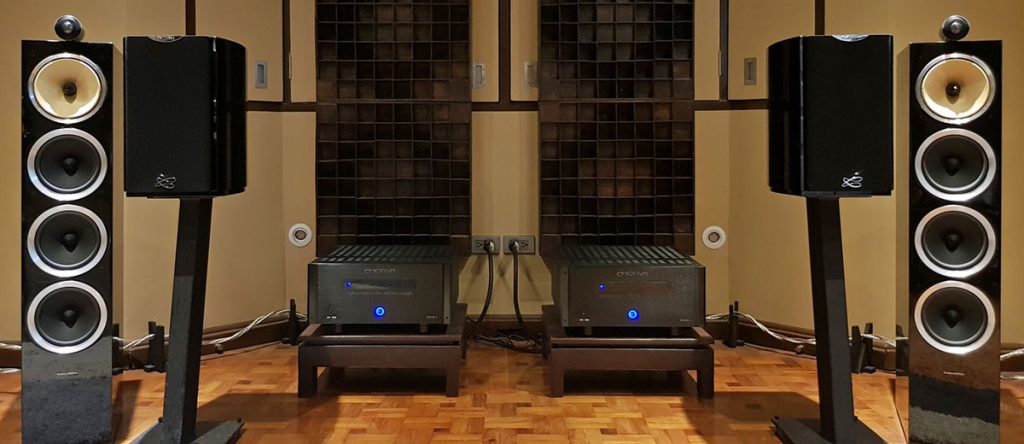
Our Verdict
Yes, they are expensive. The local asking price of the Cabasse Murano comes out to roughly US$3,400. However, they look expensive and they sound expensive. Clearly, a painstaking amount of R&D, manufacturing, and quality control that went into them.
With one listen you know exactly where your money went. With its excellent reproduction of recorded space, pinpoint imaging, revealing nature, astounding bass, and effortless dynamics, it was as though I was listening to a pair of well-designed floor standing speakers, not the small bookshelf speakers they actually are. The Muranos sound big and in a very pleasing way.
Are they worth it? To my ears, they certainly are. Highly recommended.
Cabasse Murano Specifications
- Dimensions: 38,5 x 24,8 x 30 cm
- Weight: Product: 14kg
- Frequency Response: 48 Hz – 24 kHz
- Efficiency: 87 dB/W/m
- Nominal Impedance: Compatible with 8 ohms
- Driver Complement: One Coaxial midrange-tweeter BC13 and one 17 cm 17ND36 woofer
- Crossover Points: 800Hz and 3.5kHz
- Cabinet Design: Ported
- Power Handling: 150 watts nominal, 1,000 watts peak
- Serial Numbers Reviewed: 400203160520 and 400210160520

